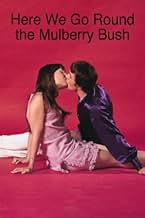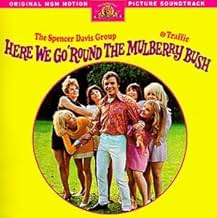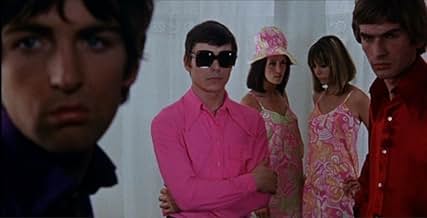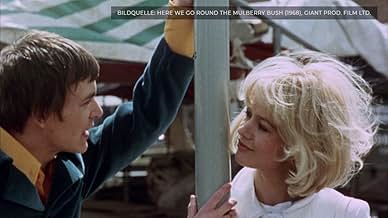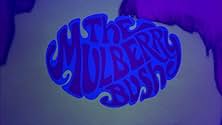Trois petits tours et puis s'en vont
Titre original : Here We Go Round the Mulberry Bush
NOTE IMDb
6,2/10
838
MA NOTE
Ajouter une intrigue dans votre langueA high-school dropout, obsessed with sex, is determined to lose his virginity.A high-school dropout, obsessed with sex, is determined to lose his virginity.A high-school dropout, obsessed with sex, is determined to lose his virginity.
Histoire
Le saviez-vous
- AnecdotesDespite the film's reputation as being an archetypal 'Swinging London' movie it was actually shot on location in Stevenage in Hertfordshire
- GaffesJamie says he is left handed, yet we see that he consistently uses his right hand (his brother Joe is left handed, however).
- Versions alternativesFor its UK cinema release the film was heavily cut from the original print with edits to dialogue, some sexual references, and all of Mary's topless footage during the bathing scene, and the uncut version was released overseas. The cut cinema print was often shown on BBC1 and the uncut version was shown by Channel 4. The 2010 DVD features both prints of the film.
- ConnexionsFeatured in Film Review: Backs British Films (1968)
- Bandes originalesHere We Go Round the Mulberry Bush
Written by Steve Winwood and Traffic
Performed by Steve Winwood and Traffic
Commentaire à la une
I'm a big fan of 60's British music and films and this quirky if slight movie marries both in a peppy attempt to show how swinging England got its nickname.
Of course it's dated greatly particularly its attitudes towards sex and by extension women, but it retains a bright playfulness, backed up by enthusiastic acting from its mostly young cast. Mind you Barry Evans and Judy Geeson aren't quite Tom Courteney and Julie Christie, and a lot of the scenes seem pretty meaningless, but driven by Evans' to-camera pieces from the outset and taking in some other tricksy pseudo-surrealistic dream sequences, flashy camera work, a touch of farce here, a touch of orgy there, while its attractions are a mite thin, at least they're just about present and correct.
The story itself amounts to little more than Evans' trying to get his end away, moving ever steadily up the ladder of the local female population in pursuit of his dream girl Judy Geeson, to learn that she has the same outlook towards men as him, only her dream doesn't stop with him. By the movie's end our fresh-faced hero is just about ready to settle down, bewitched by a beguiling smile from a young Diane Keen, at the age of it seems 18 or 19 at most.
The film is shot in a bright clear fashion, with contemporary pop music prominent in the background - Traffic's title song is ace and gets a few airings throughout. It was funny to see practically all the leads in the popular early 70's sit-com "Doctor at Large" in frame at one point - one almost expected James Robertson-Justice to barge in on the odd scene! There's a mildly surprising frolicsome nude scene between Evans and Geeson near the end, but in truth this is only a little more surprising than seeing Geeson in long trousers just before it - every other female in the film is apparently wearing a mini-skirt.
So then, while being far from the best of the British pop-art cinema of its time, it retains an odd, slightly endearing attraction to the likes of me, who just missed out on being a teen in the 60's. Based on the evidence here, it looks as if it was this generation and not its predecessor that never had it so good (and you can interpret "it" any way you like!)
Of course it's dated greatly particularly its attitudes towards sex and by extension women, but it retains a bright playfulness, backed up by enthusiastic acting from its mostly young cast. Mind you Barry Evans and Judy Geeson aren't quite Tom Courteney and Julie Christie, and a lot of the scenes seem pretty meaningless, but driven by Evans' to-camera pieces from the outset and taking in some other tricksy pseudo-surrealistic dream sequences, flashy camera work, a touch of farce here, a touch of orgy there, while its attractions are a mite thin, at least they're just about present and correct.
The story itself amounts to little more than Evans' trying to get his end away, moving ever steadily up the ladder of the local female population in pursuit of his dream girl Judy Geeson, to learn that she has the same outlook towards men as him, only her dream doesn't stop with him. By the movie's end our fresh-faced hero is just about ready to settle down, bewitched by a beguiling smile from a young Diane Keen, at the age of it seems 18 or 19 at most.
The film is shot in a bright clear fashion, with contemporary pop music prominent in the background - Traffic's title song is ace and gets a few airings throughout. It was funny to see practically all the leads in the popular early 70's sit-com "Doctor at Large" in frame at one point - one almost expected James Robertson-Justice to barge in on the odd scene! There's a mildly surprising frolicsome nude scene between Evans and Geeson near the end, but in truth this is only a little more surprising than seeing Geeson in long trousers just before it - every other female in the film is apparently wearing a mini-skirt.
So then, while being far from the best of the British pop-art cinema of its time, it retains an odd, slightly endearing attraction to the likes of me, who just missed out on being a teen in the 60's. Based on the evidence here, it looks as if it was this generation and not its predecessor that never had it so good (and you can interpret "it" any way you like!)
Meilleurs choix
Connectez-vous pour évaluer et suivre la liste de favoris afin de recevoir des recommandations personnalisées
- How long is Here We Go Round the Mulberry Bush?Alimenté par Alexa
Détails
- Durée1 heure 36 minutes
- Couleur
- Rapport de forme
- 1.85 : 1
Contribuer à cette page
Suggérer une modification ou ajouter du contenu manquant

Lacune principale
By what name was Trois petits tours et puis s'en vont (1968) officially released in India in English?
Répondre
